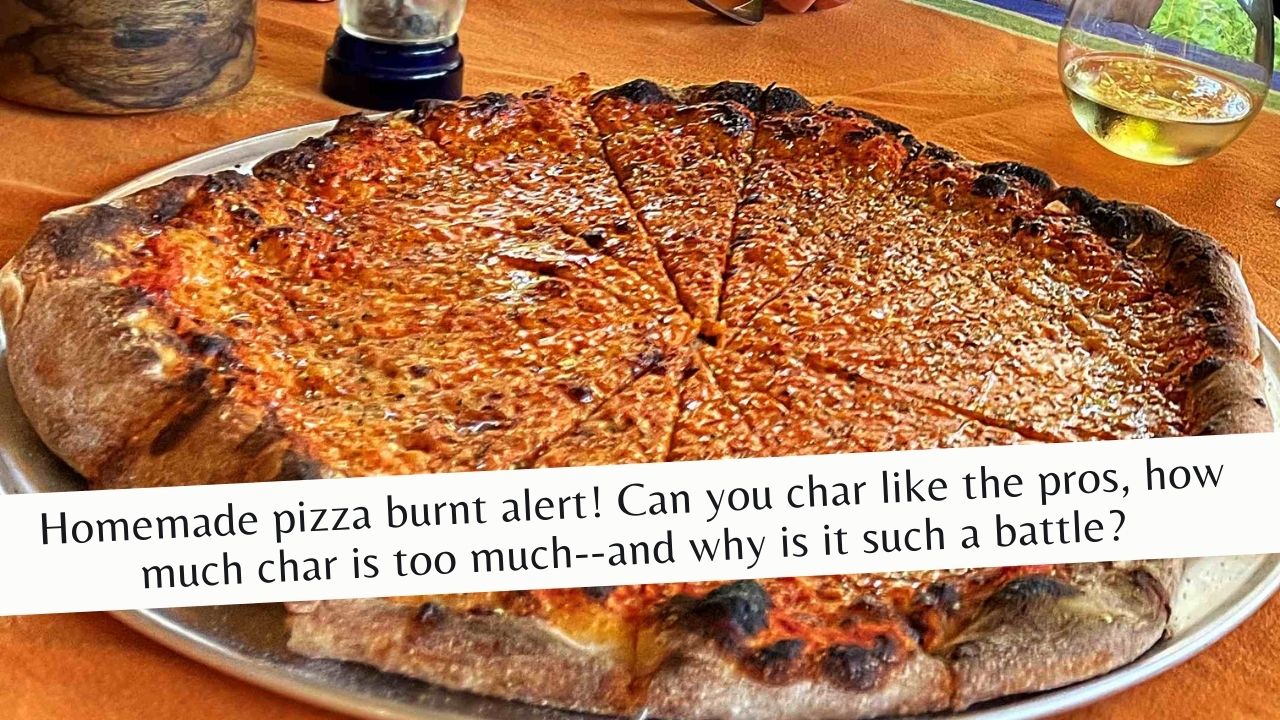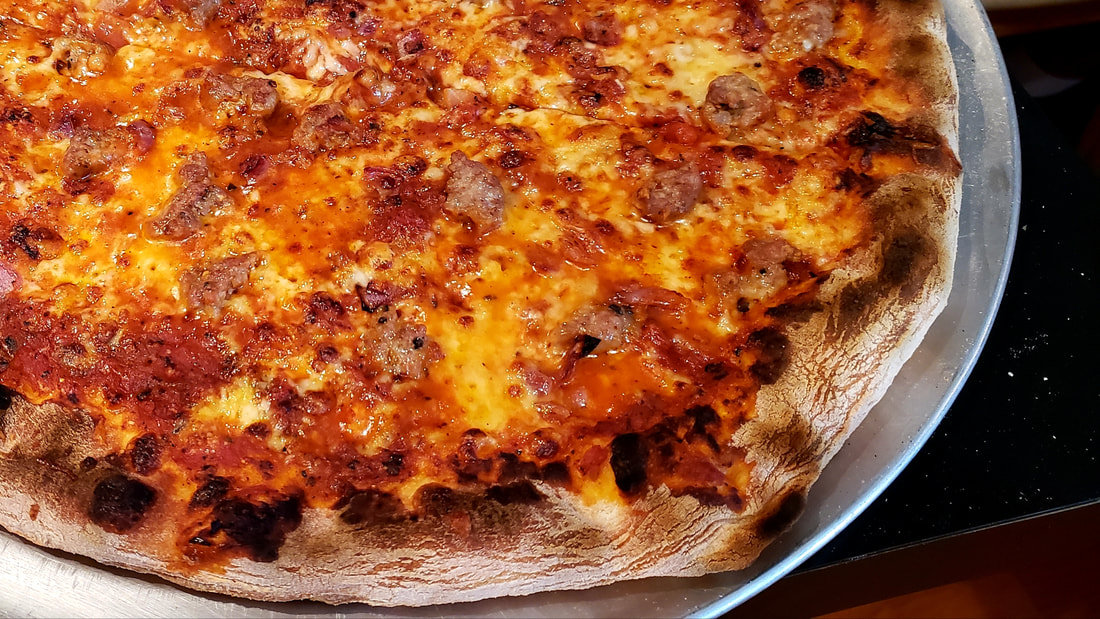|
Let’s be clear: When you make pizza, char happens. Especially if you’re doing it the way I recommend in my book Free The Pizza. I’m a big proponent of what's known as "the broiler method" for baking pizza. But why do some folks feel that char is a war to be fought far and wide? Using the broiler technique gives your home oven thermodynamic characteristics similar to those of a professional pizza deck oven. And with a little practice, the result is a pizza that people love. Char is one result of the Maillard reaction. This is the chemical reaction between amino acids and reducing sugars in cooking food. It results in (get ready) melanoidins! These are "high molecular weight heterogeneous polymers." (Yes, this will be on the quiz.) Melanoidins taste great, and you enjoy them on all kinds of foods, from pan-fried dumplings to well-seared steaks. In the Maillard process, char is a step past brown before we get to burnt. But what about char on pizza? Do people love that? I believe so. But what is char? When is it a Maillard too far? If you’re making homemade pizza in a standard home oven, there’s a chance you don’t encounter char. That’s especially true if you’re using the bake setting only. I’ve made pizza in giant, wood-fired ovens and little, portable outdoor ovens. Char there is easy. Maybe too easy. The blurry black line between charred and burnt has been crossed when the food is inedible. And I know at least one disgusted newbie pizzamaker who was repeatedly retrieving blackened homemade pizza discs from his new outdoor oven and just flinging them from the peel into the yard. If you’ve ever had proper Neapolitan pizza, you’ve experienced leoparding: little black dots of char that appear on the pizza's outer rim, or the cornicione. That’s considered an authentic Neapolitan-pizza aesthetic. If you’ve ever had New Haven pizza, especially from world-famous Pepe’s Apizza on Wooster Street, you know that char is a much heralded feature. The edges of the pizza are supposed to be black and crackly or it’s not done. (If you’re New Haven curious, you probably want to watch the documentary Pizza: A Love Story. New Haven char is a big part of the story. Surprisingly, so are some big stars—including Lyle Lovett, Henry Winkler and Michael Bolton.) There are also people who hate this aesthetic. Some are convinced New Haven pizza lovers are being held captive and it’s a form of culinary Stockholm syndrome. (I’ve had New Haven pizza, and while I understand the anti-char view, I can’t say that I necessarily agree that so much char is a problem.) Ultimately, it’s all about what you enjoy. Some people enjoy a New York-style pizza with an outer edge that’s very pale. I prefer one that’s brown and has a few charred bubbles here and there. Most of mine look that way. Recently, I shared the photo of the pizza you saw at the top of the page. (A pizza which, by the way, our guests raved about. Someone who’s eaten easily a dozen different pizzas of mine said, “Of all the pizzas you've made for me, I think this is my favorite.”) Kevin Godbee, a fellow pizza geek, took one look at that photo and said, “Looks spectacular! Looks like a New Haven pizza.” (If you’re interested, you can see his pizza blog here.) And I admit, the amount of char is at the limit. More would have been too much. And a writer at one of the major food websites (major enough that it has been recognized a dozen times by the James Beard Foundation) wrote an article that piqued the ire of opinionated pizza geeks everywhere: “Pizza Chefs: Please Stop Burning My Pies!” Subhead: “When did char become a badge of honor?” What is burnt, what is simply charred, and who is to judge? I agree that my pizza in the top photo is significantly charred. The pizza below is less so, and the amount of char there is impossible to avoid when attempting to give the crust that crispy brown cornicione. And this next one was interesting. I made this about a year ago, and when I took a bite of the crust, I thought: This is different. It’s not quite burnt. But it is quite dark. And It could arguably be too much. I liked it , but my wife (who has an excellent if sensitive palate) thought it went too far. One problem people have with char is bitterness. When it extends to excessive char, they find it acrid. Others find that a charred bubble that shatters and combines with all the other flavors of the pizza make for an enjoyable contrast.
In the final analysis, it’s your pizza. Do what you want. But I recommend experimentation. Try various levels of char. I almost always serve a crispy pizza with some charred spots. I’ve heard people tell me they wake up thinking of these pizzas. They’ve been ruined for all other pizzas. They are desperate to be invited back for more pizza. It’s flattering. But it’s also objectively a measure of how much they enjoy the char, which is part and parcel of the overall crispness of the pizza. And people liking it is understandable. In food taste tests, there’s an undeniable preference for crunch. To get more char (or less char) in a home oven, you have to be vigilant. You have to use the broiler method, and watch your pizza when it’s baking. You don’t have to watch it the entire time. But you have to check. I turn on my broiler as soon as I launch a pizza. My steel is six inches below the broiler element. And I always have the oven light on so I can take a peek through the window at the baking pizza. I always turn the pizza by 3 minutes in. And sometimes the total bake is as short as 4 minutes. Other times, it can be 5 or even 6 minutes, depending on the dough and the topping load. Your level of dough hydration is going to make a difference. Whether there is sugar or oil in the dough makes a difference. Even the weather is going to make a difference. (The first time I baked pizza in high humidity, I was baffled. Occasionally, it still catches me by surprise.) And, most important, your oven is going to make a difference. The pizza in the top photo was baked in an older DCS oven. High-end ovens don’t seem to get as hot as less expensive ovens, judging from the temperature of the steel after an hour of pre-heat. But they bake more quickly and evenly, and often their broilers get hotter. I presume they are better insulated. The second pizza was baked in my home oven, which is a mid-level GE Profile. I’ve learned how to best work with it to deliver a pizza that looks that way. The third pizza, the one that my wife found too bitter, was baked in a contractor-spec standard GE range. And I’ve often wondered: do such ovens make up for their less-expensive construction and insulation with more brute-force heat? Does that broiler perform in a way others I’ve used don’t? These are all questions I don’t have the answer to. (But I’m going to go off in search of them for my next book.) And this all underscores the importance of paying attention to your oven and your pizza. Controlling the amount of char requires learning to roll with the flow of that hot metal box of wire racks we call a home oven. Char is good. Unless it’s not. That’s up to you. When a pizza is crispy with some char, I consider it fully baked. Your mileage may vary. If you're interested in making a pizza that may or may not be charred, check out the simple and silly pizzamaking manual, Free The Pizza: A System For Making Great Pizza Whenever You Want With The Oven You Already Have by clicking here.
0 Comments
Leave a Reply. |
AuthorBlaine Parker is the award-winning author of the bestselling, unusual and amusing how-to pizza book, Free The Pizza. Also known as The Pizza Geek and "Hey, Pizza Man!", Blaine is fanatical about the idea that true, pro-quality pizza can be made at home. His home. Your home. Anyone's home. After 20 years of honing his craft and making pizza in standard consumer ovens across the nation, he's sharing what he's learned with home cooks like you. Are you ready to pizza? Archives
July 2024
Categories
All
|
© Copyright 2021, 2022, 2023, 2024. All rights reserved.
As a ShareASale Affiliate and an Amazon Associate, we earn a small percentage from qualifying Amazon purchases at no additional cost to you.
When you click those links to Amazon (and a few other sites we work with), and you buy something, you are helping this website stay afloat, and you're helping us have many more glorious photographs of impressive pizza.
When you click those links to Amazon (and a few other sites we work with), and you buy something, you are helping this website stay afloat, and you're helping us have many more glorious photographs of impressive pizza.




 RSS Feed
RSS Feed